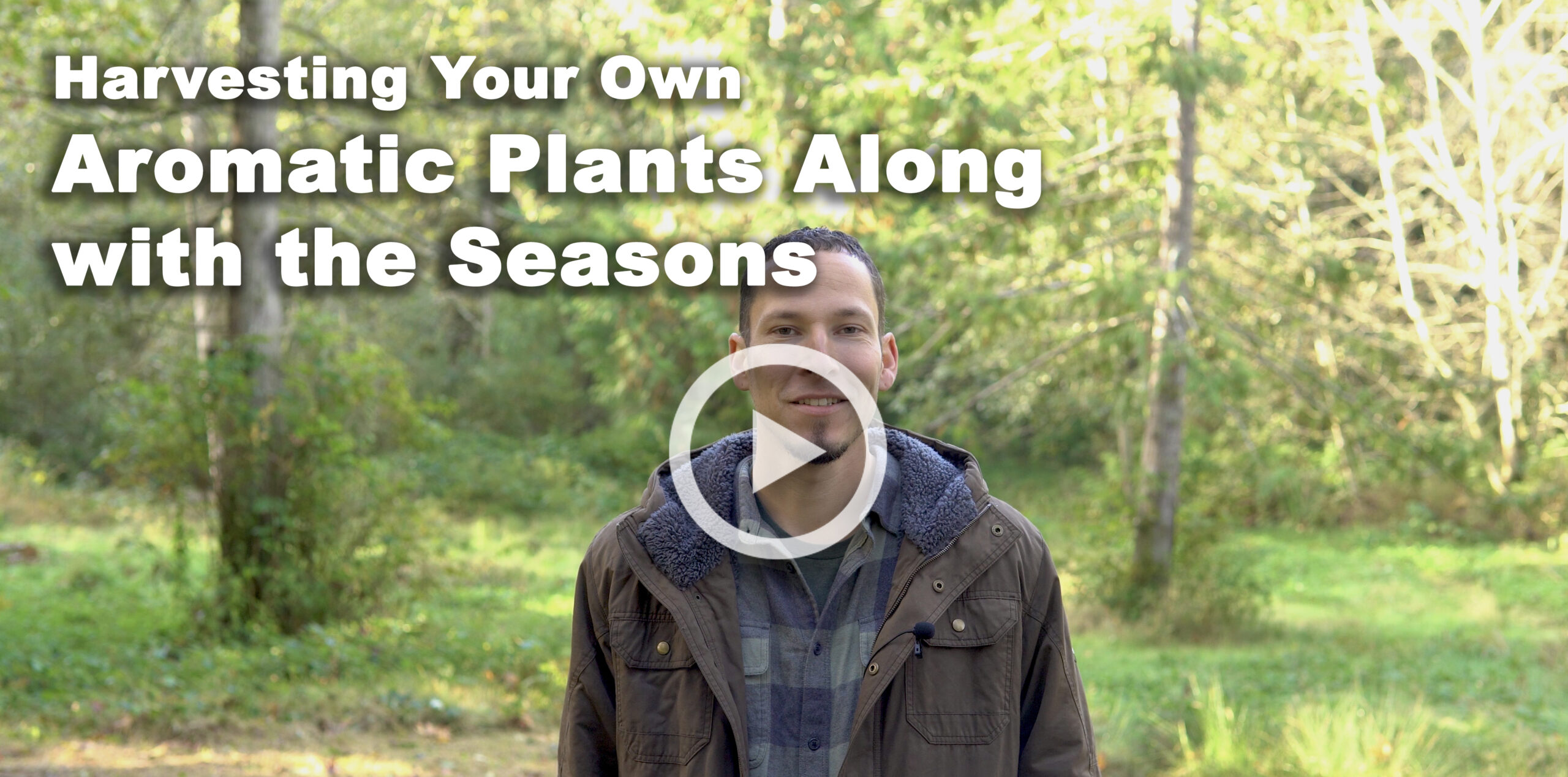In my recent vlog post I talked about the importance of Bio-regional Aromatic Medicine and connecting with and learning about your own local aromatic plants growing around where you live. We all have our family of local herbs waiting to be discovered. Our own medicine chest and array of aromatics that herbalists and healers in our unique regions have been using for thousands of years.
But there's an important practice I wasn't able to share with you in that video that goes hand in hand with Bio-regional Aromatic Medicine. That is, the practice of Seasonal Wild-Harvesting and learning to be in sync with the rhythms of nature and plants.
For ages plant people have observed nature and the plat kingdom intimately. They've discovered that along with the weather and our own transforming and adapting human lives, the energies within plants also ebb and flow along with outside influences.
The changing seasons, elements, the sun, moon, stars, and planetary positions all affect how and when plants move their life force within their bodies. Equipped with this knowledge, each of us can learn when the most ideal times are to harvest our botanicals from plants--when their medicines, aromatic constituents, and life forces will be the most potent.
If you already harvest your own botanicals from the wild, or if you're feeling called to start doing so, the medicines you make with wild plants are not only going to be more potent and full of life, but your personal connection to your practice is strengthened in the process, unlocking new profound experiences and more enjoyment being outdoors, and giving you the satisfaction of seeing the process through from out in the forest, all the way to a finished medicine or product that you, a friend, or patient is enjoying or finding healing from. There's nothing like wild-harvesting your own medicine.
Today we're so used to buying everything online or from the store. Most people are just used to shopping with the click of a button and taking a package of herbs or essential oils out of their mailbox. That's where it starts for a lot of herbalists and aromatherapists. Which is totally fine. Understandably, a lot of folks just can't seem to find the time to do much of anything these days, let alone take a trip down the road to harvest plants.
But I'll tell you, the rewards for making the time are profound...
It’s totally okay to buy exotic herbs and spices, but getting to know your own local flora at the same time will change your plant practice in powerful ways. You’ll learn so much having real-life, human-to-plant connections, and you’ll gain many great and powerful plant allies in the process—and also a lot of beautiful and likely transformational experiences that aren’t as easy to come by if you strictly buy your herbs, essential oils, or other botanicals. There’s a lot to say about the practice of putting your own hands into the different processes that come before a finished product is purchased.
It’s incredibly beneficial to learn as much as you can about the plants you work with locally. Each of us has a treasure chest of gems waiting to be unlocked—our own wild garden of herbs right outside our door—that truthfully, most people are simply unaware of.

Seasonal Harvesting of Plant Parts
There’s a lot of magic and wisdom waiting for all of us in our local wilderness, and even right in your own backyard if you learn to listen and tap into nature more deeply. And when you learn to follow the changes of the seasons, observe the many local species of medicinal and aromatic plants and how they live and change throughout the year—watching what they produce, smelling them, and learning about their natural histories and their traditional uses over time—you'll understand their aromatic medicine deeply and know how to heal people more effectively with them.
Plants have a rhythm with how they move their life force according to the seasons, and when you’re wild crafting your own botanicals, or growing your own in your garden, it’s important to know how to read these rhythms.
You can actually visually see where plants put their energies, or life force, and how they move them. You'll notice in the spring, a dead-looking, bare branch will burst to life with a single vibrant green shoot or bud, eventually turning into a leaf of flower. Or in the summertime you’ll watch a flower bloom and die, and see a fruit appear over time, ripening in its place.
We've all known how plants transform like this since when we were children. It's all pretty simple and intuitive, of course. But most of us don't realize that if we follow this energy flow and time our harvesting to be in sync with it, our harvest will literally have more aromatic and medicinal constituents within it, along with more vitality and life force.
For example, right now in the northern hemisphere, during the fall months tree resins, gums, roots, woods, and roots are all glowing with life force, ready to be harvested at their maximum potency. This is because the energies within plants are cooling down after the summer months, and moving inward and downward after producing leaves, flowers, fruits and seeds.
The life force of plants is concentrated during this time within the woods and resins, and in the winter months it will be highly concentrated in a plant's root system before moving back upwards and outwards in the spring and summer.
The thing to keep in mind is that not all plants are on the same schedule. Some plants shift into the next phase early, some later. The key is to get to know your plants by observing them and learning to harvest them with your own hands. Through your experience you'll know first-hand the best times to harvest each species you work with.
Here's the general breakdown of the most ideal times to harvest certain plant parts:
Spring: fresh shoots, leaves, buds, some grasses, early blooms, early flowers (at their peak)
Summer: foliage of all kinds, grasses, needles, flowers, buds, early fruits
Fall: fruiting bodies of all kinds, seeds, pods, resins, gums, branches, bark, woods, heartwood, roots
Winter: woods, heartwood, roots
Again, this is a general rule of thumb. Many plants will push the boundaries as late or early bloomers. An important note when harvesting aromatic plants specifically, is that a plant or plant part is most potent, most full of its medicine when it is also at its peak aromatic potency. When a plant or part of a plant smells the strongest it contains the highest level of aromatic constituents. This is most often the ideal time of harvest.
With this knowledge in mind, go out and start meeting new local plant friends, or learn more about old allies through careful observation and experimenting with harvesting seasonally, and have fun doing so!
Unlock Your Free Issue Of...
🌿 The Aromatic Medicine Garden Membership 🌿
Are you ready for a deeper, holistic dive into the world of aromatic plants? See what our membership is all about with your free sneak peek issue, including an hour-long plant talk and a 21-page plant profile pdf full of recipes and insights.

Article & Video by Evan Sylliaasen

Evan Sylliaasen is the founder of the Northwest School of Aromatic Medicine and Higher Mind Incense. For the past decade his incense company has been a leader in sustainability and conscious sourcing of aromatic plants. As the head instructor of his online school, he teaches aromatherapists, incense lovers, herbalists, and spiritually-minded folks the traditional art of incense crafting, incense as medicine, and the art of wild-harvesting aromatic plants responsibly.
Evan lives with his family in the foothills of the Olympic Mountains of Washington state. He channels his creative passions through writing, photography, wood working, craftsman building, and music. When he’s not working, he’s out in the garden, forest and fields, walking along rivers, beaches, or in the mountains breathing deeply.
© 2020-2021 The Northwest School of Aromatic Medicine. All rights reserved.
*The statements above have not been evaluated by the FDA, and are for educational purposes only. This article is not intended to diagnose, treat, cure, or prevent any disease. This article should not be taken as medical advice. Please consult your physician before you use this information for health purposes.
